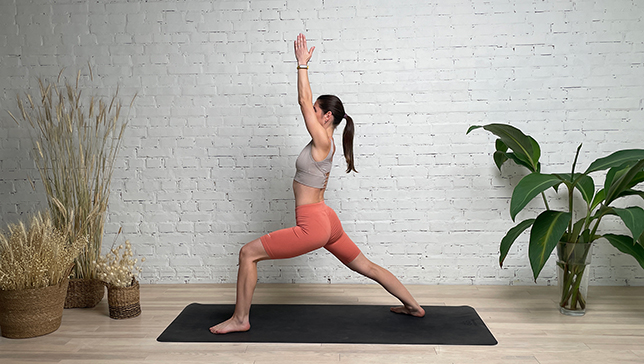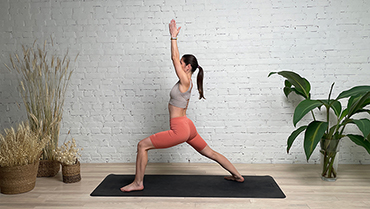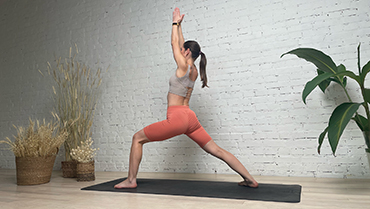Warrior Pose I - Warrior Pose I

Contents
As per Hindu Mythology, ‘ Virabhadra’, was the name of a ‘Warrior’, created by Lord Shiva. Hence this pose comes from the creation of the fiercest warrior by Lord Shiva and so the name goes as ‘Virabhadrasana’ or ‘Warrior’ Pose. In Sanskrit ‘Vira’ means ‘Hero’ ‘Warrior’ ‘Vigorous’ and ‘Courageous’, and ‘Bhadra’ means ‘good’ ‘auspicious’.
Considered to be a powerful posture replicating the power of a warrior, this pose is the first variation amongst the many under warrior poses. The importance of practicing this pose is emphasised clearly in all schools of yoga as it forms a part of the standing poses which includes balance, stability and stamina. To balance the body with feet more than hip distance apart and raising the arms above your head while gazing at them, requires one to connect the body with the breath. Practicing the alignment of the feet and the knees, along with the torso marks as a great pose to add beauty to one’s body.
Warrior Pose I is considered a base pose as Warrior Pose I variations can be derived from this pose. Warrior Pose I helps boost energy in the body and hence can be included in different yoga sequences.
Pose Detail
- Difficulty: Beginners
- By Type: Chest Opening Yoga Poses, Hip Opening Yoga Poses, Shoulder Opening Yoga Poses, Strengthening Yoga Poses
- Body Position: Standing Yoga Poses
- By Benefit: Yoga Poses For Weight Loss
Step-by-Step Instructions
Benefits and Contraindications
Stretches the chest and lungs, shoulders and neck, belly, groins (psoas)
Strengthens the shoulders and arms, and the muscles of the back
Strengthens and stretches the thighs, calves, and ankles
High blood pressure
Heart problems
Students with shoulder problems should keep their raised arms parallel (or slightly wider than parallel) to each other.
Students with neck problems should keep their head in a neutral position and not look up at the hands.
Photo poses in different angles


Modifications And Props For Beginners
Warrior Pose is considered a beginner to intermediate yoga pose, but it can be difficult at first. To master the pose, you can start by modifying it with props:
- Use a wall: Stand facing a wall with your arms extended, and place your hands on the wall for support. Step one foot back and bend the front knee, coming into Warrior 1. Use the wall to support your balance and alignment.
- Use a chair: Stand facing a chair and place your hands on the backrest. Step one foot back and bend the front knee, coming into Warrior 1. Use the chair to support your balance and alignment.
- Use a block: Place a block under your front foot to elevate the heel and provide more stability. This can be especially helpful if you have tightness or discomfort in the hips.
- Use a strap: If you have limited shoulder mobility, you can use a strap to help you bring your arms overhead. Hold the strap with both hands and extend your arms overhead, keeping the strap taut.
Useful Tips
Find a comfortable and stable stance to start.
To prevent the front knee from collapsing in, wrap the muscles around the outer hip to externally rotate the leg.
To prevent the ribs from flaring out, engage the core and draw the tailbone down towards the mat, which also keeps the lower back long.
Frequently Asked Questions
If you have knee pain, it’s important to proceed with caution when practicing Warrior 1. Consider modifying the pose by bringing your front foot closer to your back foot or using a block to elevate your front heel. You can also try focusing on engaging your glutes and thighs to take pressure off the knees.
Warrior I primarily works the quadriceps, glutes, and hamstrings, as well as the muscles of the back and core. It also requires balance and stability, which engages the smaller stabilizing muscles of the legs and feet.
As with any yoga pose, the length of time you hold Warrior I will depend on your experience level and personal preferences. Generally, you may hold the pose for 5-10 breaths, gradually increasing to 30 seconds or longer as you become more comfortable with the posture.
Warrior I is a grounding and energizing pose that can help to calm the mind and reduce stress and anxiety. Focus on your breath and your connection to the ground as you hold the pose, allowing any tension or worry to melt away.
Variations
- Warrior Pose I With A Chair
- Warrior Pose I Block Between Foot And Wall
- Warrior I Straight Legs Prayer Hands
- High Lunge Pose
- Crescent Low Lunge Pose
- Peaceful Warrior Pose
- Revolved Eight Point Crescent Moon Pose